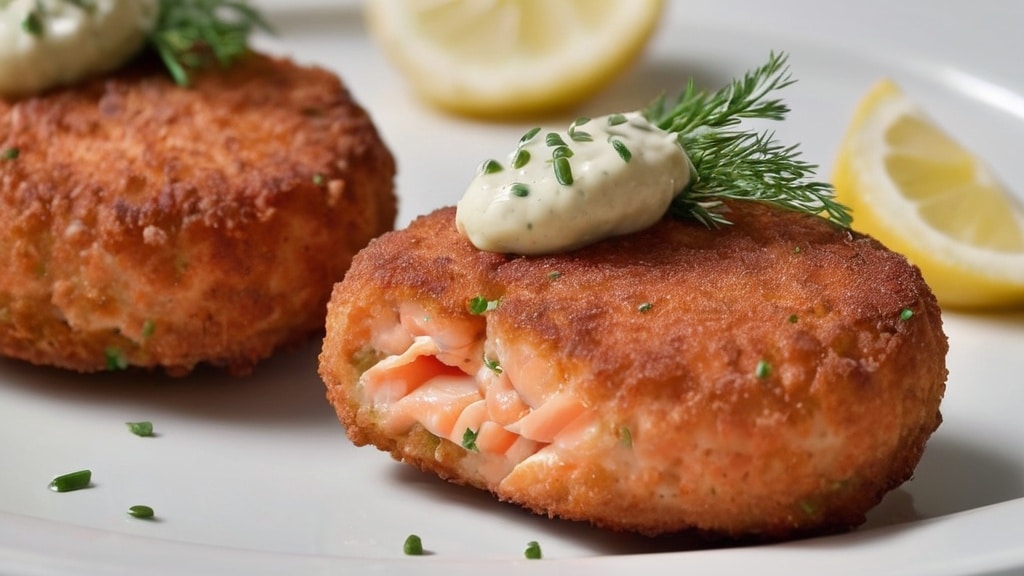The first time I encountered salmon croquettes, I was seven years old, peering over my grandmother’s kitchen counter in coastal Maine. The sizzle of those golden patties hitting hot oil is a memory etched into my culinary conciousness. What struck me wasn’t just the incredible aroma that filled our tiny kitchen, but how she transformed leftover salmon into something entirely magnificent with just a handful of pantry staples. It’s funny how some recipes stick with ya for decades.
Salmon croquettes represent the beautiful intersection of resourcefulness and culinary brilliance. These crispy-on-the-outside, tender-on-the-inside patties showcase fresh salmon in a way that elevates this everyday protein to something truly special. Unlike their canned-salmon counterparts (which have their place in home cooking), fresh salmon croquettes offer superior texture, cleaner flavor profiles, and endless opportunities for creative expression in the kitchen.
Ingredients & Substitutions

The Foundation
- 1 pound fresh salmon fillet, skin removed
- 1 cup panko breadcrumbs, divided (½ cup for mixture, ½ cup for coating)
- ⅓ cup finely diced red bell pepper
- ¼ cup finely diced celery
- ¼ cup minced shallots (or substitute 3 tablespoons red onion)
- 2 tablespoons fresh chopped dill
- 2 tablespoons mayonnaise
- 1 tablespoon Dijon mustard
- 1 large egg, lightly beaten
- Zest of one lemon
- 2 tablespoons fresh lemon juice
- ½ teaspoon old bay seasoning
- ¼ teaspoon cayenne pepper (optional)
- Salt and freshly ground black pepper to taste
- 3 tablespoons high-quality olive oil for frying
For those dealing with gluten restrictions, almond flour makes an exceptional substitue for panko breadcrumbs, creating a slightly nuttier profile that pairs beautifully with salmon’s natural richness. The texture won’t be quite as light, but the flavor compensation is worth it. If egg allergies are a concern, a flax egg (1 tablespoon ground flaxseed mixed with 3 tablespoons water) provides adequate binding properties, though your croquettes might need an extra minute in the pan to achieve proper cohesion.
When selecting salmon, wild-caught varieties like sockeye or coho deliver a more robust flavor profile compared to farm-raised Atlantic salmon. However, high-quality farmed salmon can be equally delicious with a milder, buttery character. The critical factor is freshness – your salmon should smell clean and oceanic, never “fishy.” This recipe also presents a brilliant opportunity to repurpose leftover cooked salmon, which will produce a slightly different but equally delightful texture.
Step-by-Step Instructions
Preparing the Salmon
- Poach the salmon in a shallow pan with enough simmering water to barely cover the fillets, along with a bay leaf and a few peppercorns. Cook for approximately 5-7 minutes until just opaque in the center. Many home cooks overcook salmon for croquettes—remember that it’ll cook further during frying, so slight undercooking at this stage is ideal.
- Once poached, transfer the salmon to a plate and allow it to cool completely before flaking with two forks. Be mindful to maintain some texture; overmixing will result in pasty croquettes rather than the delightful varied mouthfeel we’re aiming for.
- While the salmon cools, sauté your diced vegetables (bell pepper, celery, and shallots) in a teaspoon of olive oil over medium heat until just softened, about 3-4 minutes. This pre-cooking step ensures your vegetables won’t remain raw in the finished croquettes, which would disrupt both texture and flavor release. Allow the vegetable mixture to cool before proceeding.
Making the Mixture
- In a large mixing bowl, combine the flaked salmon, sautéed vegetables, ½ cup panko, chopped dill, mayonnaise, Dijon, beaten egg, lemon zest and juice, and seasonings. Gently fold everything together using a rubber spatula or your hands (I prefer hands for better control and tactile feedback). A common misstep is overworking the mixture—aim for just enough mixing to distribute ingredients evenly while maintaining distinct pieces of salmon.
- Cover the mixture and refrigerate for at least 30 minutes, though 1-2 hours is preferable. This resting period allows the flavors to meld while the breadcrumbs absorb moisture, creating a mixture that holds togther better during shaping and cooking. If your pressed for time, 15 minutes in the freezer can substitute, though texture won’t be quite as perfect.
- After chilling, form the mixture into patties approximately 2½ inches in diameter and ¾ inch thick. For consistent cooking, uniform size is crucial. A standard ice cream scoop provides perfect portioning. If the mixture seems too wet, add another tablespoon of panko; if too dry, a touch more mayonnaise restores proper consistency.
Cooking the Croquettes

- Place the remaining ½ cup panko in a shallow dish and gently press each croquette into the crumbs, coating both sides. For an extra crispy exterior, you might be tempted to double-dip in egg wash and crumbs, but resist this urge—the delicate flavor balance of fresh salmon croquettes benefits from a lighter coating.
- Heat olive oil in a heavy-bottomed skillet (cast iron is ideal) over medium heat until shimmering but not smoking. A drop of water should sizzle immediately upon contact. Working in batches to avoid crowding, cook the croquettes 3-4 minutes per side until golden brown and heated through. Overcrowding the pan is the enemy of crispness—it drops the oil temperature and creates steam, resulting in soggy exteriors.
- Transfer finished croquettes to a wire rack set over a baking sheet rather than paper towels. This prevents condensation from softening your perfectly crisp crust. If making a large batch, keep finished croquettes warm in a 200°F oven while completing the remaining patties.
Cooking Techniques & Science
The magic of salmon croquettes lies in the perfect balance between binding and moisture retention. Unlike beef or pork patties that rely heavily on protein binding, fish croquettes require additional ingredients to create cohesion. This is where the egg protein and breadcrumb starch matrix becomes essential, working together to form a network that traps moisture while maintaining structural integrity during cooking.
Poaching the salmon rather than roasting or pan-searing serves a distinct purpose. The gentle, moist heat penetrates the fish evenly without developing a crust or caramelization, which would compete with the golden exterior we’re aiming to achieve during the final frying stage. Additionally, poaching helps preserve the salmon’s natural oils, which contribute significantly to the croquette’s luxurious mouthfeel.
Pan-frying salmon croquettes triggers the Maillard reaction—a complex series of chemical reactions between amino acids and reducing sugars that creates hundreds of flavor compounds and that appealing golden-brown color. Maintaining the proper oil temperature (around 350°F) is critical; too hot and the exterior burns before the interior warms; too cool and the croquettes absorb excess oil, becoming greasy and heavy.
For those without an instant-read thermometer, the wooden spoon test works remarkably well: place the handle of a wooden spoon in the oil—if small bubbles form around it immediately, the oil is ready. Alternatively, a small piece of breadcrumb should sizzle gently upon contact without immediately darkening.
Serving & Pairing Suggestions
Plating salmon croquettes presents numerous creative opportunities. For an elegant presentation, arrange three croquettes in a triangle atop a swoosh of sauce, garnishing with micro greens and edible flowers. In more casual settings, nestle them on a bed of lightly dressed arugula, where the peppery notes complement the salmon’s richness.
The classic accompaniment is a tangy remoulade sauce, which cuts through the richness with acidic brightness. My preferred version combines ½ cup mayonnaise, 1 tablespoon chopped capers, 1 tablespoon chopped cornichons, 1 teaspoon Dijon mustard, 1 teaspoon fresh lemon juice, and a dash of hot sauce. A lighter alternative is tzatziki, offering cooling cucumber notes against the warm croquettes.
Wine pairing calls for something with sufficient acidity to balance the richness yet enough body to stand up to the salmon’s flavor intensity. A coastal Spanish Albariño or Oregon Pinot Gris excels here. For beer enthusiasts, a Belgian saison provides complementary herbal notes and effervescence that cleanses the palate between bites.
These croquettes showcase remarkable versatility. Serve them as an elegant appetizer with a dot of crème fraîche and caviar, as the protein component of a main course alongside roasted vegetables, or as the star of a brunch spread with poached eggs. They even work beautifully in sandwich form, tucked into a brioche bun with avocado and sprouts.
Conclusion
Fresh salmon croquettes represent that rare culinary achievement—a dish that feels simultaneously luxurious and approachable, complex yet comforting. The technique you’ve mastered here translates beautifully across seafood varieties; try substituting poached cod for a lighter version or incorporating smoked trout for deeper complexity.
The true artistry in perfecting salmon croquettes comes from understanding balance—between moisture and structure, seasoning and subtlety, tradition and innovation. Each batch offers the opportunity to fine-tune these elements to your personal preference. Perhaps you’ll add finely chopped fennel for an anise note or incorporate toasted sesame seeds into your coating for added nuttiness and texture.
Remember that patience plays a crucial role in exceptional salmon croquettes. Allow time for proper chilling, maintain appropriate frying temperature, and resist the urge to flip prematurely. These small disciplines yield remarkable dividends in your final result. With practice, you’ll develop an intuitive sense of when the mixture feels “just right” before cooking—a skill that distinguishes remarkable cooks from merely competent ones.
FAQs
Can I make salmon croquettes ahead of time?
Absolutely! You can prepare the mixture up to 24 hours in advance and keep it refrigerated. For best results, shape the croquettes just before cooking. Alternatively, form the patties, place them on a parchment-lined sheet, and freeze until solid. Transfer to an airtight container with parchment between layers, where they’ll keep for up to one month. Cook directly from frozen, adding about 2 minutes per side to the cooking time.
Why do my salmon croquettes fall apart during cooking?
Several factors could cause this frustrating issue. First, check that your mixture had adequate binding (egg and mayo) and sufficient resting time in the refrigerator. Second, ensure your pan and oil reached proper temperature before adding the croquettes—cold oil leads to absorption rather than instant exterior setting. Finally, resist the temptation to flip or move the croquettes too early; they need time to develop a crust that helps maintain integrity.
Can I bake these instead of frying?
While frying delivers superior texture contrasts, baking offers a healthier alternative with good results. Preheat your oven to 425°F, place the formed croquettes on a parchment-lined baking sheet, spray or brush with oil, and bake for 15-20 minutes, flipping halfway through. The exterior won’t achieve quite the same golden crispness, but the flavor profile remains excellent. For a compromise approach, pan-sear briefly on both sides, then finish in a 375°F oven for 5-7 minutes.
How can I tell when salmon croquettes are fully cooked?
Unlike raw meat patties that require specific internal temperatures, salmon croquettes (made with pre-poached fish) primarily need heating through rather than “cooking” to a certain doneness. They’re ready when the exterior is golden brown and crisp, and the center feels hot when tested with a metal skewer (hold it in the center for 5 seconds, then touch it to your lip—it should feel distinctly warm). If using raw salmon in your mixture, ensure the centers reach 145°F for food safety.
What’s the best way to reheat leftover salmon croquettes?
To restore crispness, avoid microwave reheating, which creates steam and soggy exteriors. Instead, place croquettes on a wire rack over a baking sheet in a 350°F oven for 7-10 minutes. Alternatively, reheat in a dry skillet over medium-low heat, turning occasionally, until warmed through. For repurposing leftovers entirely, crumble cold croquettes into scrambled eggs or atop a salad for a delicious transformation that doesn’t require reheating.

